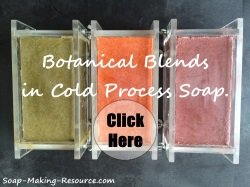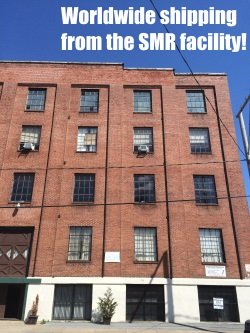Natural Botanicals Blends in Soap Making
Here at Soap Making Resource we LOVE natural botanicals and the beautiful colors that they produce in soap. Within this demonstration, we are excited to show you the vibrant hues that you can achieve through strategically mixing specific sets of SMR's all-natural botanicals. That's right; you can actually combine colorful natural botanical blends in soap making to achieve various hues within your finished product! Today, we are going to show you the beautiful soaps that you can produce with 3 different botanical mixtures. These blends include madder root powder and Moroccan red clay, paprika powder and safflower powder and finally, comfrey leaf powder and spirulina powder. We hope you enjoy this picture demonstration!
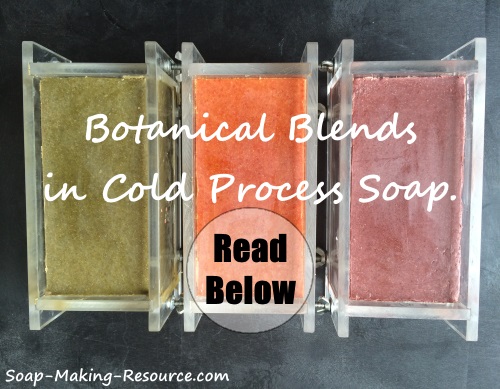
As you can see in the picture above, when mixed together, madder root powder and Moroccan red clay will produce a beautiful purplish-burgundy color, paprika powder and safflower powder will produce a deep orange hue and finally, comfrey leaf powder and spirulina powder will produce a fabulous avocado green. Below is a picture of the 3 different botanical blends that we will be using in our cold process soap batches.
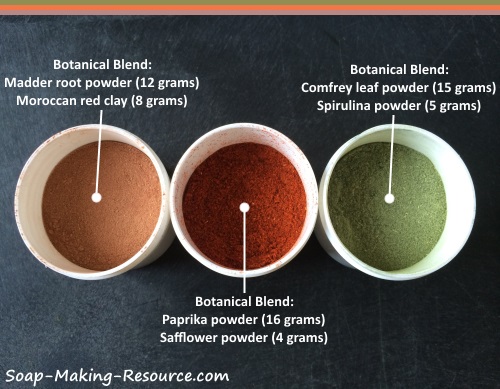
In our first 2 pound soap batch, we are adding a combination of 12 grams of madder root powder and 8 grams of Moroccan red clay. This is a ratio of 3 parts madder root powder to 2 parts Moroccan red clay. For those of you who want to change your batch size, you can easily multiply out your botanical portions accordingly. Also, keep in mind that this 20 gram botanical blend is being mixed into our 2 pound cold process soap batch. This results in an overall botanical usage rate of approximately 2.2%. For general information about using botanical blends in cold process soap, be sure to click here now for helpful tips, hints and guidelines!
Below is a picture of us pouring our finished madder root powder and Moroccan red clay soap into the Soap Making Resource 2 pound no-line acrylic log soap mold. Isn't it beautiful!
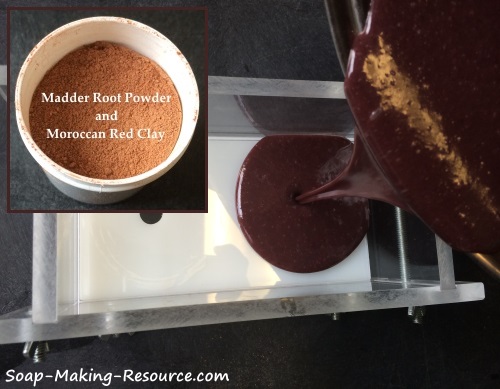
Next is a picture of our soap after it has fully solidified. As you can see, the color of our batch has changed slightly after this initial cure.
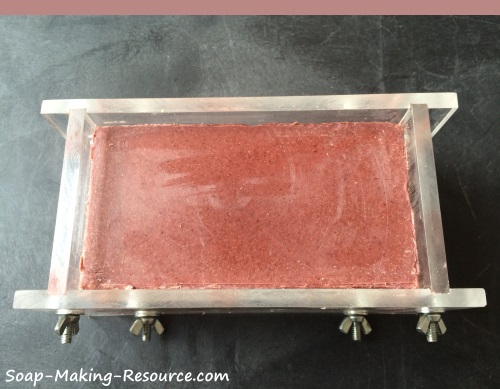
|
Sign Up Today!
*Your information is SAFE with us! |
In our second 2 pound soap batch, we are adding a combination of 16 grams of paprika powder and 4 grams of safflower powder. This is a ratio of 4 parts paprika powder to 1 part safflower powder. For those of you who want to change your batch size, simply multiply out your botanical portions accordingly. Also, just like our previous batch, this 20 gram botanical blend is being mixed into our 2 pound cold process soap recipe resulting in an overall botanical usage rate of approximately 2.2%. Don't forget, for general information about using botanical blends in cold process soap, be sure to click here now for helpful tips, hints and guidelines. They may just be useful to you for when you make these botanical blend soaps on your own!
Below is a picture of us pouring our finished paprika powder and safflower powder soap into the Soap Making Resource 2 pound no-line acrylic log soap mold. I just LOVE the beautiful orange hue that was produced by this fantastic botanical blend!
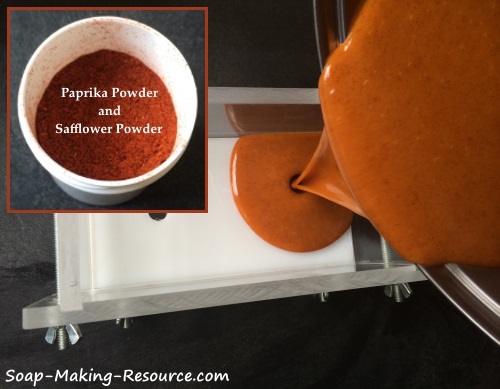
Next is a picture of our soap after it has fully solidified. As you can see, the color of our batch has changed slightly after this initial cure, but the transformation is a little more subtle than the madder root powder and Moroccan red clay batch.
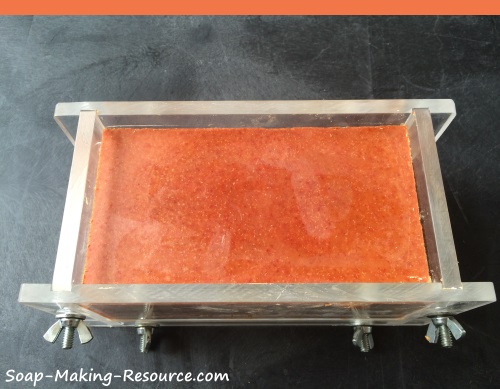
In our final 2 pound soap batch, we are adding a combination of 15 grams of comfrey leaf powder and 5 grams of spirulina powder. This is a ratio of 3 parts comfrey leaf powder to 1 part spirulina powder. For those of you who want to change your batch size, you can multiply out your botanical portions accordingly. Just like the previous 2 batches, this 20 gram botanical blend is being mixed into a 2 pound cold process soap batch resulting in a 2.2% approximate overall botanical usage rate. Remember, for general information about using botanical blends in cold process soap, be sure to click here now for helpful tips, hints and guidelines!
Below is a picture of us pouring our finished comfrey leaf powder and spirulina powder soap into the Soap Making Resource 2 pound no-line acrylic log soap mold. This deep green hue is truly mesmerizing... and to think that it was produced using only all-natural botanicals!
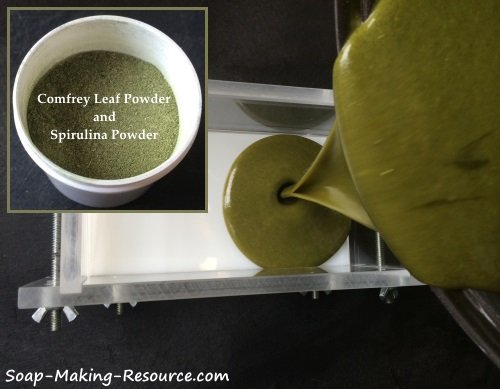
Next is a picture of our soap after it has fully solidified. As you can see, there were some slight changes in color to our soap after this initial cure.
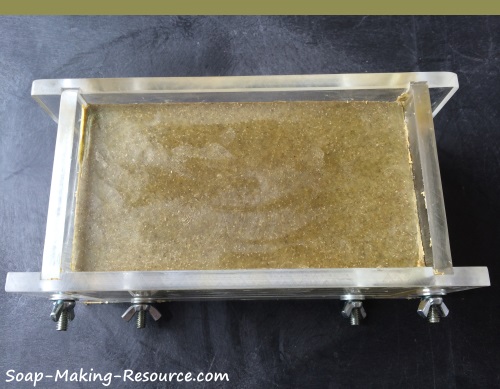
Now that you have seen the beautiful colors we achieved through using our 3 unique natural botanical blends, below I will share with you some general tips, hints and guidelines for using naturally colorful botanical mixtures in cold process soap making:
- Avoid using too high of a botanical usage rate as this may cause the color produced by the botanical to "bleed" from the soap ultimately resulting in stained washcloths and possibly even stained bathtubs! Yes... even colors produced with natural botanicals may "bleed" from your soap if your proportions are too high!
- You can adjust your botanical proportion ratios to achieve a new shade. For example, instead of mixing madder root powder and Moroccan red clay at a 3 to 2 ratio respectively, try mixing them at a 2 to 3 ratio or 4 to 1 ratio and see what kind of new color you can come up with!
- You can adjust your total botanical usage rate to achieve new hues. In each of our test batches, we used an approximate 2.2% total botanical usage rate. Try cutting this amount in half or increase it a little bit to achieve various shades. Just don't add too much, or else (as stated above) the botanical color may "bleed" from your soap!
- Some additives like essential oils or fragrance oils may affect the color of your soap (especially citrus essential oils and vanilla based fragrance oils), so adjust how you use your botanical and expect alterations in your final color when creating a batch using certain color-affecting ingredients!
- Colors that are produced in soap from natural botanicals may change over time. Remember, SMR's botanicals are not synthetically manufactured to produce 100% predictable results, so expect the unexpected when it comes to natural soap making... especially when using plant materials for color!
- Some botanicals may be PH sensitive causing your resulting color to vary depending on your specific soap recipe base formula, super-fat level, water discount level and a variety of other factors. When using botanicals to color soap, you will never know exactly what your resulting color will be... You may have a general idea, but the exact hue will remain a mystery until you complete your batch. That's all part of the fun!
- For best results, only mix "like" colors together to achieve unique shades of that specific color. For instance, try mixing SMR's black walnut hull powder (dark brown) with SMR's cocoa powder (light tannish-brown) for a distinctive natural brown hue, but avoid mixing "unlike" colors together like indigo powder (blue) and turmeric powder (yellow). Unlike synthetic dyes that are manufactured to be mixed together to achieve a unique color, a yellow botanical mixed with a blue botanical may not yield a pretty green hue. More than likely, your results will be unattractive and "muddy". Of course, here at SMR, we have not tried every botanical combination under the sun, so feel free to experiment and see what kind of results you can achieve. Be sure to report to us your findings!
- Strategically blending botanicals may help stabilize your finished product's color. Having trouble keeping your greens? Try adding a more stable natural green material, like French green clay, to your botanical mix and see if that helps!
- Allowing your soap to heat up and go through the "gel" phase may affect the final hue of your botanically colored finished product. Allowing your soap to go through the "gel phase" (which is usually accomplished through insulating your batch to cause the heat produced by saponification to build up) often creates a finished product with darker and more vibrant hues. In contrast, soap that does not go through the "gel" phase often has more creamy pastel-like colors. Whether or not you "gel" your soap is completely a matter of personal preference and you will likely develop your own style as you learn this fantastic art form! To learn more about the "gel" phase, check out SMR's madder root soap making tutorial. It's a long demonstration, but within that lesson, you will see exactly how the "gel" phase can affect your product's final color.
- When adding natural botanicals to your soap, it is best to separate a small portion of soap from your main batch at a light trace and then thoroughly mix your plant material into this smaller portion. When mixing botanicals into a large batch, it can sometimes be difficult to tell if there are any unknown botanical clumps present within your soap that remain undetected. Our recommended method of mixing your plant material into a smaller portion of soap first, will allow you to better ensure that the botanical has been thoroughly mixed into your batch and no unwanted clumps are present. Once you are sure that your botanical has been fully mixed into your small soap portion, pour this colored soap into the rest of your batch.
- Some botanicals can thicken your soap batch and drastically increase trace. Be sure to mix in your botanicals at a light trace to allow for as much time as possible to thoroughly integrate your plant materials.
Thank you all for taking a look at our natural botanical blend tutorial. We hope that you enjoyed it! As you can see, natural botanical blends are a fantastic way to produce beautiful and unique hues in homemade soaps without using synthetic dyes! Remember, if you have any questions about this tutorial, or any other tutorial on soap-making-resource.com; please feel free to contact us. We are always more than happy to help you!
Also, don't forget that all ingredients used within this tutorial are available to purchase right here at soap-making-resource.com. We sincerely appreciate your business!
Have fun browsing the Soap Making Resource website and be sure to check out some of the other tutorials on soap-making-resource.com. We hope that you like them!
Return from the natural botanical blends in soap making demonstration to the soap recipes hub page.

